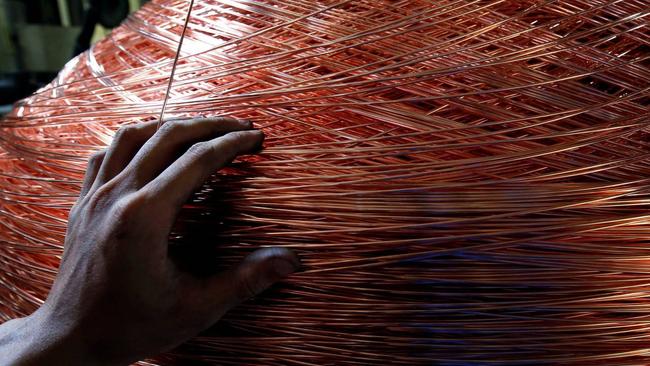Copper, lithium sectors differ but fundamentals strong in both
Renewable energy relies heavily on critical metals such as copper and lithium, yet despite this commonality the markets that supply and consume these two metals are very different.

The global push to reduce carbon emissions will transition energy infrastructure away from fossil fuels and towards renewable energy sources. Renewable energy relies heavily on critical metals such as copper and lithium, yet despite this commonality the markets that supply and consume these two metals are very different.
All commodities – but especially metals – are subjected to price cycles. Periods of low prices lead to underinvestment, which leads to shortages and higher prices and overinvestment. Copper mining typically requires large investment as the mines require scale and take many years to develop. This has been further accentuated by recent macro-economic factors such as cost inflation and rising capital expenses, effectively increasing the investment hurdles for launching new projects.
Lithium prices have been volatile, as the relatively young market balances a rapid increase in demand in electric vehicles with the deployment of capital into new lithium producing operations. Over the past decade, lithium’s price changes have been significant, with large fluctuations and short periods of rise and fall. This shows that, while lithium demand has surged, the market has quickly added new production.
Copper is a large, mature market that is spread out and limited by supply. Its refining capacity is competitive and globally diverse, and it serves a broad range of end uses. Historically, copper has been closely linked with economic growth, though decarbonisation is expected to boost demand, especially for transmission networks. At higher prices, copper can often be substituted with aluminium.
Lithium, on the other hand, is a smaller, newer market. It is somewhat concentrated on the raw material supply side and heavily concentrated on the refining side. Its end use is primarily for high-density battery storage, mostly in electric vehicles, due to its light weight. For lithium, we expect demand to keep growing as electric vehicles are the only viable alternative to traditional engines in the short to medium term.
The sharp drop in lithium price in 2023 has affected the industry’s cost structure, likely setting a floor under prices by taking out more expensive production. We also expect ongoing price volatility in the short term, although opportunities exist in companies with low costs and long mine life, including those that are vertically integrated and able to deliver refined lithium carbonate and lithium hydroxide directly to automakers.
In the long term, we expect pricing to become benchmarked and more transparent. Lower cost and longer life operations will likely displace higher cost production, particularly those with natural advantages such as proximity to end users of lithium. Advantages such as scale and geography will ultimately smooth out price cycles, allowing for consistent, albeit more modest margins from producers, providing more certainty to industry participants.
The recent rise in copper prices has attracted a lot of attention despite significant global economic uncertainty. Production cuts by several large copper producers at the end of 2023 have flowed through the market and driven copper prices higher, along with the stocks of copper producers. We are seeing two seemingly conflicting trends – firstly that incumbent producers are enjoying a period of high-margin profitability, yet no new significant mines have been approved. This cautious approach is reflected in BHP’s recent attempted takeover of Anglo American, indicating that producers prefer acquiring existing production over starting new projects.
At current high prices, we expect some users will turn to aluminium instead of copper (almost all copper in an electric vehicle can be replaced by aluminium – while it doesn’t conduct electricity quite as well, it is much cheaper and lighter), and increased copper recycling will temper further increases in the copper price. We do not yet see any significant additional production capacity coming on and therefore expect that prices will remain at elevated levels, given supply constraints.
In addition, we expect further industry M&A as miners attempt to increase their copper exposure through acquisition of producers, although there are limited large-scale targets.
Victor Smorgon Group’s preference is to focus on investments in sectors with strong long-term fundamentals, which are present in both the lithium and copper sectors. Typically, we look for long-life, low-cost projects or operations that have optionality for future growth. Geographic location is key – an asset in a stable jurisdiction will always be more valuable than its equivalent in a more volatile region. Lastly and perhaps most importantly, we seek management teams with experience who will drive outcomes for all their stakeholders.
For Australian-listed companies, we like Metals Acquisition Corp (MAC), which was listed on the ASX early this year. The company operates the CSA mine in Cobar, NSW, which is one of the highest grade copper mines globally. Since MAC took control in 2023, the mine life has already been extended beyond 10 years and management are focused on further exploration and cost reduction, which we expect will improve margins and provide strong cashflows into the future.
In lithium, Victor Smorgon Group recently participated in funding Vulcan Energy Resources (VUL), which is developing the Zero Carbon Lithium project in Germany. The company has developed proprietary technology to extract lithium from geothermal brines which will supply Europe with green battery-grade lithium for car manufacturing.
Ben Salter is experienced investment manager with the Victor Smorgon Group, with a demonstrated history of working in the mining and metals industry.





To join the conversation, please log in. Don't have an account? Register
Join the conversation, you are commenting as Logout